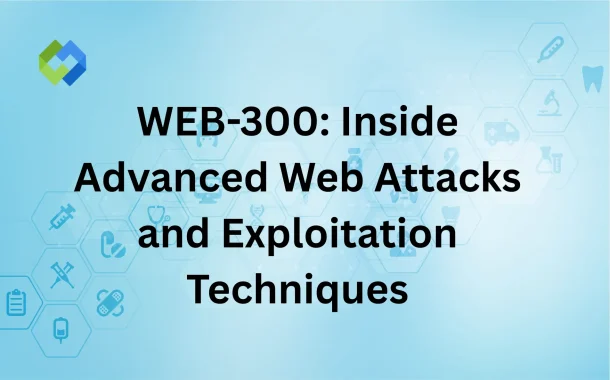Table of Contents
Table of Contents
Understanding the WEB-300 Course Foundation
The Offensive Security Web Expert (OSWE) certification represents one of the most challenging and respected credentials in the cybersecurity industry. Unlike traditional multiple-choice certifications, the OSWE certification demands hands-on expertise through a grueling 48-hour practical examination that tests real-world web application exploitation skills.
WEB-300, officially titled “Advanced Web Attacks and Exploitation,” forms the cornerstone of this certification journey. The course delivers an intensive deep-dive into sophisticated web application vulnerabilities and exploitation techniques that go far beyond basic SQL injection or cross-site scripting attacks. Students engage with complex scenarios that mirror real-world enterprise environments, where modern security controls and defensive mechanisms create additional layers of complexity.
The curriculum spans approximately 90 days of access to course materials, labs, and practice environments. This extended timeline reflects the depth and complexity of the subject matter, allowing students to develop mastery through repetitive practice and experimentation. The course structure acknowledges that becoming proficient in advanced web exploitation requires sustained effort and dedicated practice time.
Core Curriculum and Technical Skills Development
The WEB-300 course curriculum covers an extensive range of advanced topics that prepare students for the most challenging web application security scenarios. Students begin by exploring advanced SQL injection techniques that bypass modern web application firewalls and input sanitization mechanisms. These advanced injection methods include time-based blind injection, union-based exploitation, and techniques for extracting data from heavily filtered environments.
Cross-site scripting (XSS) exploitation receives comprehensive treatment, moving beyond simple alert boxes to sophisticated payload construction for session hijacking, credential theft, and browser exploitation. Students learn to craft polymorphic payloads that evade content security policies and modern XSS protection mechanisms implemented by browsers and security appliances.
Template injection vulnerabilities form another critical component of the curriculum. Students explore server-side template injection (SSTI) across multiple templating engines, learning to identify vulnerable implementations and craft payloads that achieve remote code execution. This includes working with popular frameworks like Jinja2, Twig, and FreeMarker, understanding the unique exploitation vectors each presents.
Deserialization attacks represent one of the most sophisticated attack vectors covered in the course. Students dive deep into Java deserialization vulnerabilities, learning to construct gadget chains that bypass security controls and achieve code execution. The curriculum extends beyond Java to cover .NET deserialization, PHP object injection, and other language-specific serialization vulnerabilities.
Advanced Exploitation Methodologies
The WEB-300 course distinguishes itself through its emphasis on chaining vulnerabilities to achieve maximum impact. Students learn to identify and exploit complex attack scenarios where multiple moderate-severity vulnerabilities combine to create critical security exposures. This approach mirrors real-world penetration testing engagements where single high-severity vulnerabilities are increasingly rare.
Code review and white-box testing methodologies receive significant attention throughout the curriculum. Students develop skills in static code analysis, learning to identify subtle vulnerabilities in application source code that might escape automated scanning tools. This includes understanding common coding patterns that introduce security weaknesses and developing systematic approaches to manual code auditing.
The course places substantial emphasis on bypass techniques for modern security controls. Students learn to circumvent web application firewalls, content security policies, same-origin policy restrictions, and other defensive mechanisms that complicate exploitation in contemporary web environments. These skills prove essential for security professionals working in mature organizations with layered security architectures.
Authentication and authorization bypass techniques form another crucial curriculum component. Students explore advanced session management vulnerabilities, privilege escalation vectors, and techniques for bypassing multi-factor authentication implementations. The course covers both client-side and server-side authentication bypass methods, providing comprehensive coverage of this critical attack surface.
Laboratory Environment and Practical Application
The WEB-300 laboratory environment provides students with access to carefully crafted vulnerable applications that simulate real-world scenarios. These applications incorporate modern frameworks, security controls, and architectural patterns commonly found in enterprise environments. The lab design ensures that students encounter realistic challenges rather than contrived academic exercises.
Students work through progressive difficulty levels, beginning with guided exercises that introduce core concepts and advancing to complex challenges that require independent research and creative problem-solving. This graduated approach helps build confidence while ensuring comprehensive skill development across all course objectives.
The laboratory includes applications built with various technologies and frameworks, exposing students to the diverse landscape of modern web development. From traditional server-side rendered applications to modern single-page applications with API backends, students gain exposure to the full spectrum of contemporary web architecture patterns.
Each laboratory exercise includes detailed documentation and guidance for getting started, but students must develop their own methodologies and approaches for achieving exploitation objectives. This balance between guidance and independence prepares students for the self-directed nature of the OSWE certification examination.
Examination Preparation and Certification Process
The journey toward OSWE certification culminates in a challenging 48-hour practical examination that tests students’ ability to identify and exploit advanced web application vulnerabilities under time pressure. The examination format requires students to demonstrate mastery across multiple vulnerability classes and exploitation techniques covered in the WEB-300 curriculum.
Examination preparation extends beyond technical skill development to include time management, documentation practices, and stress management techniques. Students must develop efficient methodologies for reconnaissance, vulnerability identification, and exploitation that can be executed reliably under examination conditions.
The certification examination requires students to produce detailed documentation of their exploitation activities, including proof-of-concept code and step-by-step reproduction instructions. This documentation requirement ensures that successful candidates can not only exploit vulnerabilities but also communicate their findings effectively to technical and non-technical stakeholders.
Success in the OSWE certification examination requires sustained preparation over several months. Most students report spending 6-12 months in focused preparation, combining course study with independent research and practice on supplementary vulnerable applications and platforms.
Career Impact and Professional Recognition
Earning the OSWE certification creates significant opportunities for career advancement in cybersecurity roles focused on application security and penetration testing. The certification’s reputation for difficulty and practical relevance makes it highly valued by employers seeking elite security talent.
The skills developed through WEB-300 and demonstrated through OSWE certification prepare professionals for senior-level roles in penetration testing, security consulting, and application security engineering. The deep technical expertise required creates natural pathways into specialized roles that command premium compensation in the cybersecurity job market.
Beyond individual career benefits, the OSWE certification contributes to broader organizational security capabilities. Certified professionals bring advanced vulnerability identification and exploitation skills that enhance security testing programs and improve overall application security postures.
Conclusion and Next Steps
The WEB-300 course and OSWE certification represent the pinnacle of web application security education, demanding significant commitment but delivering transformational professional benefits. The comprehensive curriculum, practical laboratory environment, and rigorous certification process ensure that successful candidates possess genuine expertise in advanced web exploitation techniques.
For cybersecurity professionals ready to advance their careers and tackle the most challenging web application security scenarios, the WEB-300 course provides an unparalleled educational experience. The journey requires dedication, persistence, and substantial time investment, but the resulting OSWE certification opens doors to elite opportunities in the rapidly growing cybersecurity field.














